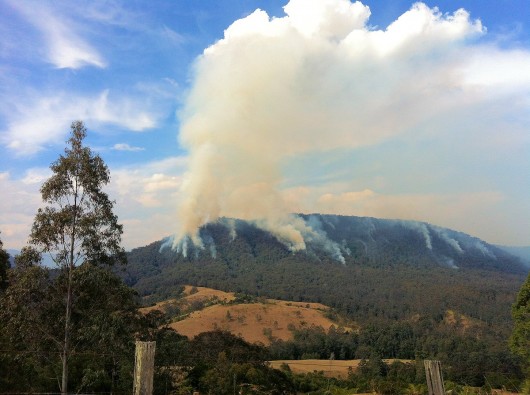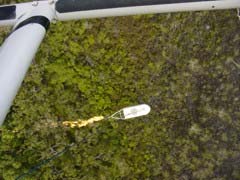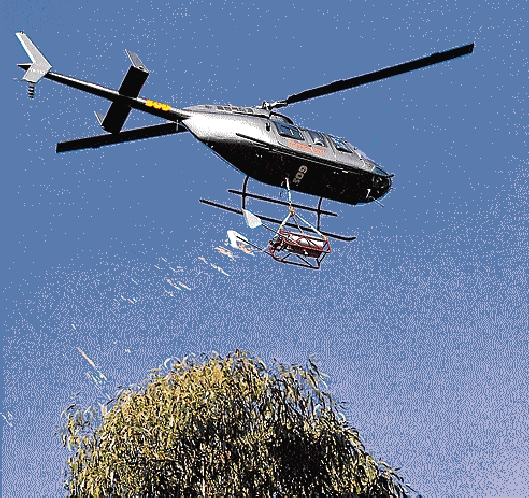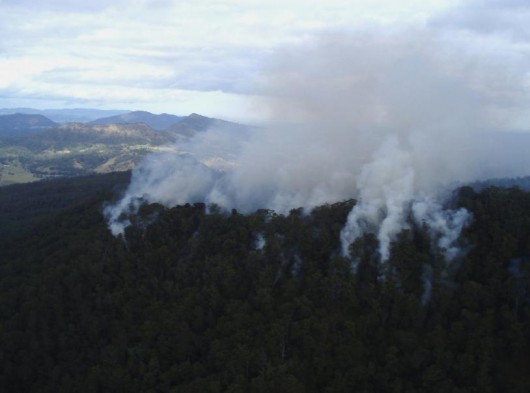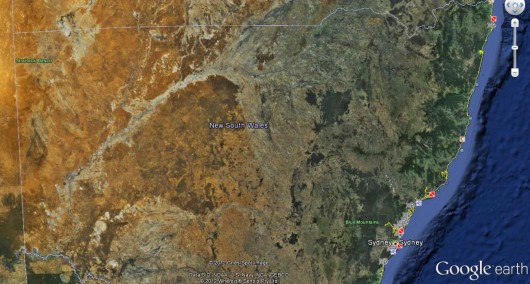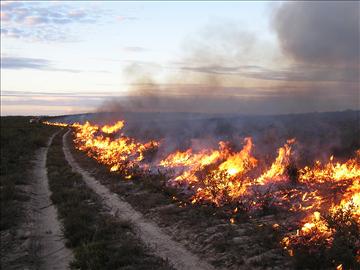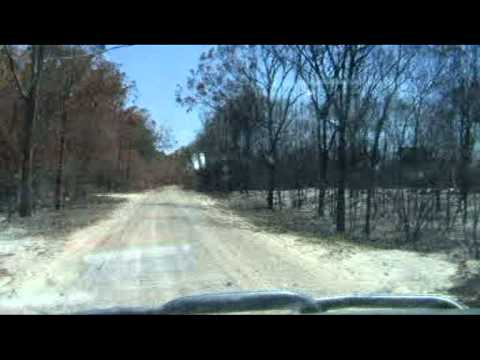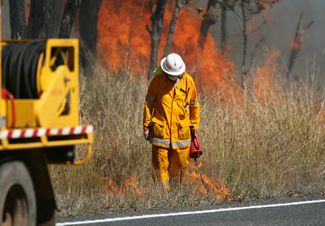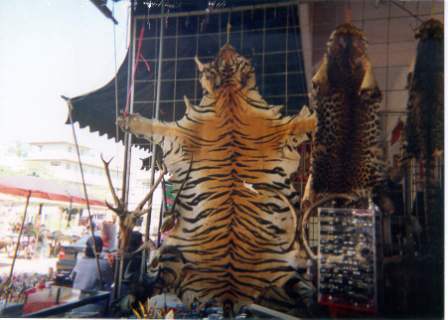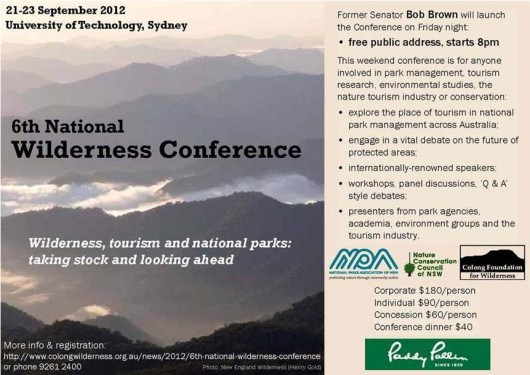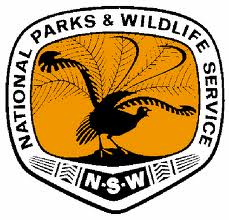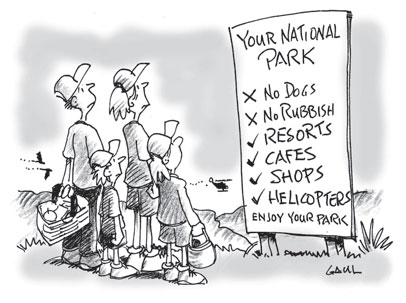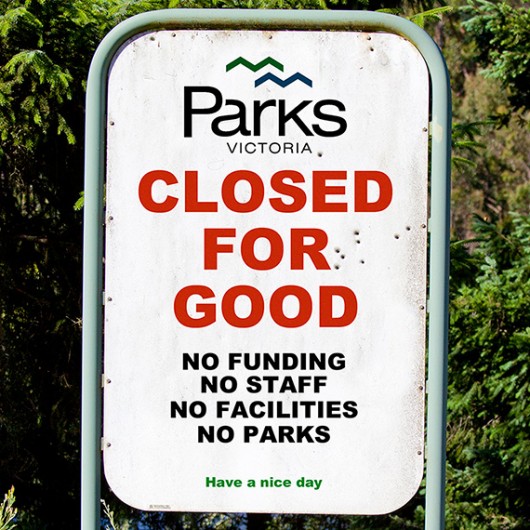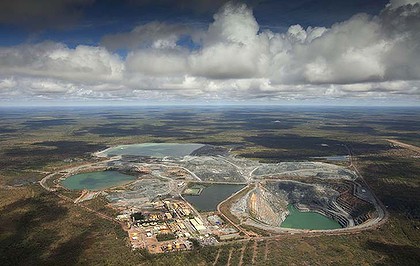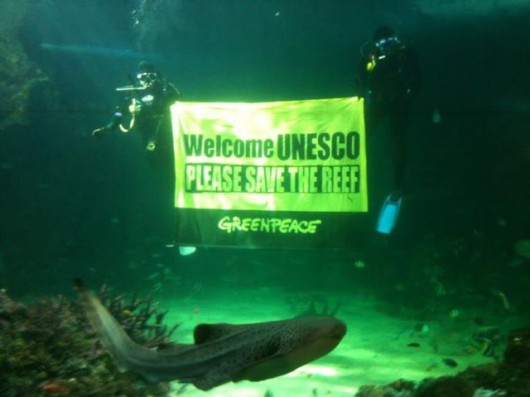Camp Florentine arson attack Sun 20120909
Monday, September 24th, 2012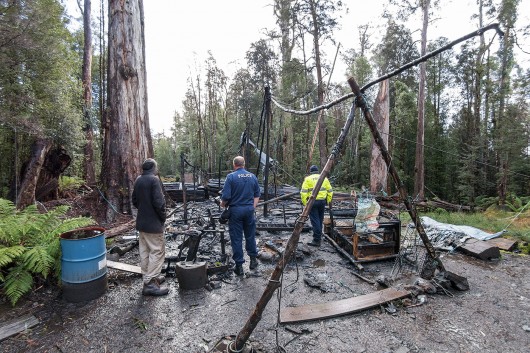 Tasmanian Police inspect arson at Camp Flozza
Upper Florentine Valley, South West Tasmania
Thursday 20120913
(click image to enlarge)
Tasmanian Police inspect arson at Camp Flozza
Upper Florentine Valley, South West Tasmania
Thursday 20120913
(click image to enlarge)
.
Still Wild Still Threatened’s Camp Florentine (Camp Flozza) has been subject to an arson attack the weekend before last. It is estimated that it was torched on Sunday night 9th September 2012. But since the camp had been unattended by environmentalists, the destruction was not discovered until some days later, by which time it had burnt itself out, perhaps with the help of rain.
Personal and campaign property has been damaged and destroyed, a car has been stolen from the site, and the information tent and camp structures were torn down and burnt. Police have inspected the site and the fire is being treated and investigated as arson.
It is believed that the arson was a misguided revenge attack by disgruntled loggers in response to an arson incident three nights prior at Les Walkden Enterprises at the nearby town of New Norfolk and connected vandalism the Saturday night prior of machinery owned by the same company at a logging coupe 12km south of Butlers Gorge in the Central Highlands.
Yet, Detective Constable Craig Fry, investigating the two attacks on the Walkden business has said that “they do not appear to be linked to any kind of protest activity.” So the subsequent arson attack on Camp Flozza was a case of mistaken identity – frustrated loggers happy to kneejerk blame conservationists (Greenies) for everything and anything. Being night time, the arsonists were probably on the turps. Perhaps the two attacks on Les Walkden Enterprises, which have caused over $800,000 damage, were intended to have the Greenies take the wrap.
Detectives are investigating all three crimes.
“This violent attack on the camp is an assault on the forest campaign. The camp is a peaceful protest movement and this incident is an act of intimidation towards protesters and the community involved in the camp” said Still Wild Still Threatened spokesperson Miranda Gibson.
 Arson Attack on Camp Flozza Sunday night 9th September 2012
Arson Attack on Camp Flozza Sunday night 9th September 2012
.
Miranda Gibson:
‘It’s first thing in the morning when I get the call. “Camp has been attacked“, the voice on the end of the line is telling me. “What do you mean… attacked?“, I asked.
“Someone’s gone there and trashed it, burnt it down.”
She is talking about Camp Florentine, Tasmania’s longest running forest blockade. The camp is run by the group I’m part of: Still Wild Still Threatened. And it is a place that is very close to my heart, having spent many years spending so much of my time out there in the past.’
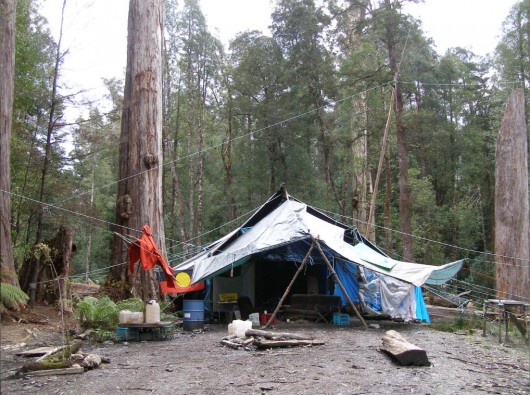 Camp Flozza front as it was before the arson attack
[Photo by editor, 20110928, free in public domain, click image to enlarge]
Camp Flozza front as it was before the arson attack
[Photo by editor, 20110928, free in public domain, click image to enlarge]
.
Miranda Gibson:
‘Camp Floz, as it is known, is in the Upper Florentine Valley, the next valley to the west of where I am located in the Observer Tree (in the Tyenna).’ [Check out ^The Observer Tree]
The Upper Florentine Valley is a large tract of ancient wilderness, that is surrounding on three sides by the World Heritage Area.’ [Check out Tasmania’s majestic ^Upper Florentine Valley]
‘Despite the protection for the surrounding mountain ranges, this valley remained unprotected because it contains such significant tracts of tall trees that the logging industry were hungry to get their hands on.’
‘Over six years ago now members of the local community became aware of Forestry’s plans to fell 15 logging coupes in the valley within three years and in response the camp was established to stop this from happening. Over those years, the constant presence of the camp has meant that the majority of those logging coupes have never been touched by a chainsaw and the forest remains standing. Hopefully it will continue to remain standing until it can take it’s rightful place as part of the Tasmanian Wilderness World Heritage Area.’
‘As well as literally stopping the logging, the camp has a range of other important functions in the campaign. Being on a main tourist road, it acts an information centre with people stopping in every day to find out about what is going on in the forest and having the opportunity to go on short guided walks. It has become a significant icon of the forest movement in Tasmania and is known to people all around the world who have stopped in on their travels.’
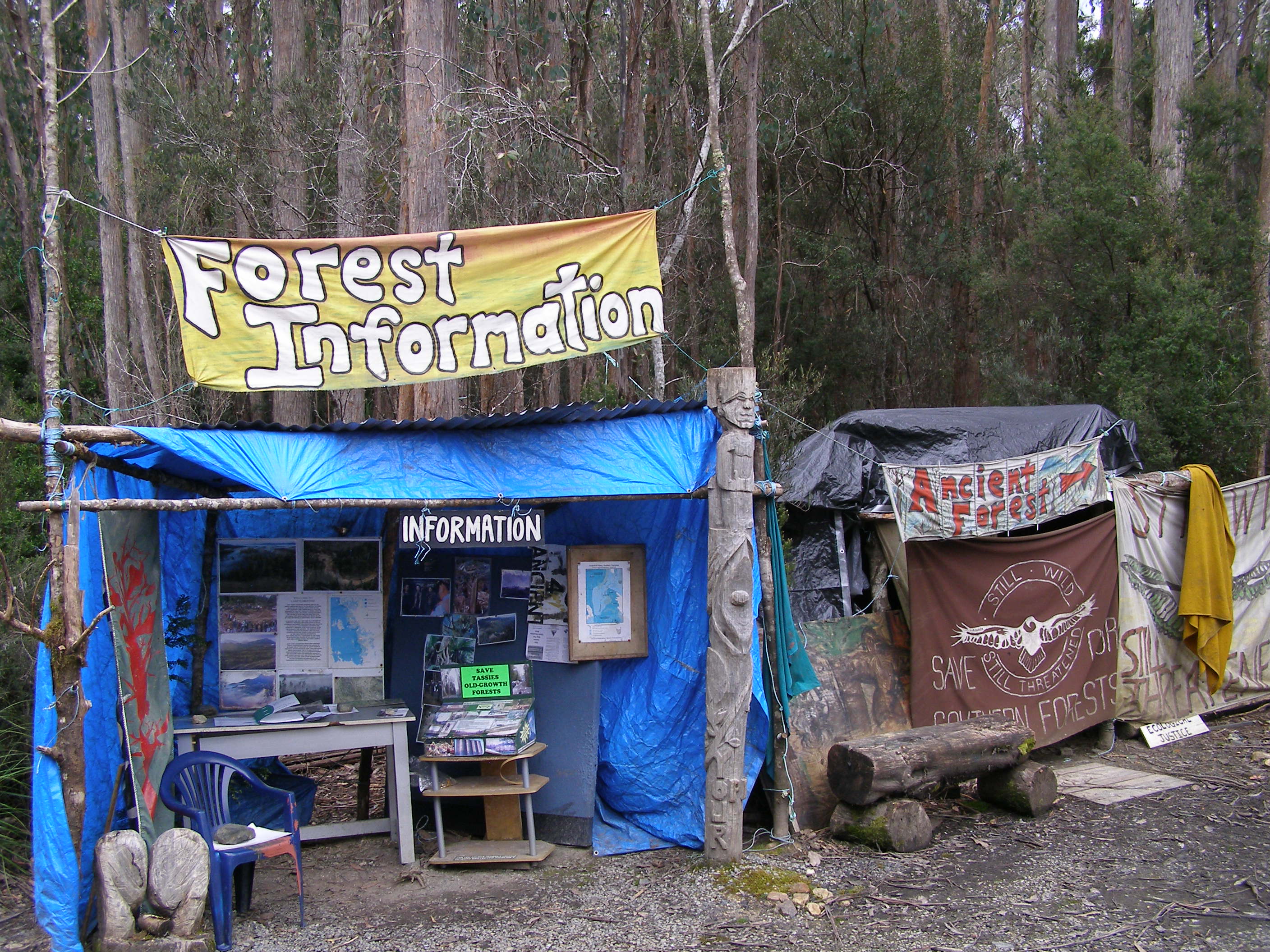 Camp Flozza Information Centre, as it was before the arson attack
[Photo by editor, 20110928, free in public domain, click image to enlarge]
Camp Flozza Information Centre, as it was before the arson attack
[Photo by editor, 20110928, free in public domain, click image to enlarge]
.
Miranda Gibson:
‘When I saw the photos I realised it was even worse than I thought. The entire camp had been torched. The main house, kitchen area and information hut were nothing but ashes.
And the camp car had been stolen.’
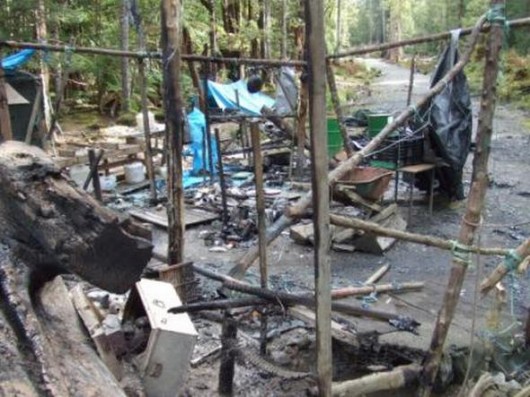 Camp Flozza arson attack on the Kitchen
[Photo courtesy of Still Wild Still Threatened 201209]
Camp Flozza arson attack on the Kitchen
[Photo courtesy of Still Wild Still Threatened 201209]
.
‘Luckily no one was at the camp when the attack occurred. The next person who was rostered on to be at the camp turned up to a horrifying scene of the camp reduced to ashes. However, one has to wonder whether the attackers would have known there was no one there, as the camp is the usually always attendance and people could have been the forest nearby.’
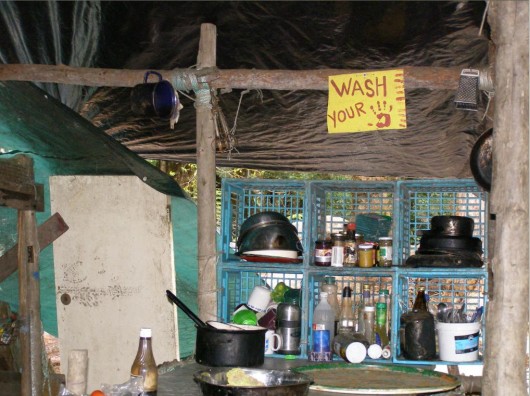 Camp Flozza Kitchen as it was before the arson attack
[Photo by editor, 20110928, free in public domain, click image to enlarge]
Camp Flozza Kitchen as it was before the arson attack
[Photo by editor, 20110928, free in public domain, click image to enlarge]
.
Camp Flozza’s front line legacy
.
Up here in the ^Observer Tree, Miranda Gibson tree-sits some ways far removed from what was happening at the camp. Yet, it had a big impact.
.
Miranda Gibson:
‘There was the practical side of things of course, as the Still Wild Still Threatened spokesperson I spent the day talking to media, police and community members. But it also was a sad day for me. Although I am not able to be there at Camp Floz, obviously, I still care deeply about the place.’
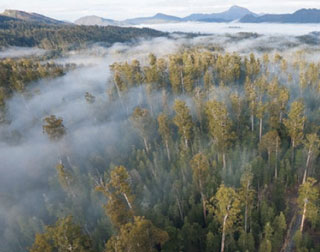 The Upper Florentine Valley
[Photo by Rob Blakers – visit his ^website]
The Upper Florentine Valley
[Photo by Rob Blakers – visit his ^website]
.
Ed: When viewing each video below and wishing to stop it, just click the pause button on the bottom left of the respective video view.
.
.
.
.
The Battle of Coupe FO044A
.
Like a poacher sees an elephant only with selfish cash-eyes through crosshairs, loggers only see native forests with selfish cash-eyes with chainsaw in hand. In Tasmania, the babyboomer government mindset cannot discern forest value from timber. The environment is still seen as a resource for industrial exploitation, just like it was in the 19th and 20th centuries. Forests are arbitrarily carved up on a logger’s map into harvestable ‘coupes’. The Upper Florentine Valley where Camp Flozza is situated is innocuously described by the Tasmanian Government as ‘Coupe FO044A‘ – sounds like a factory production batch stamped on a pallet.
It’s like how numbering of black slaves occurred through the 16th and 19th centuries’ Atlantic Slave Trade. To backward rednecks, Tasmania outside the bitumen has all been about how many ways to skin it, shoot it, trap it, log it, woodchip it, burn it, plough it, dam it, pollute it. The 19th Century Taswegian redneck element persists in logging despite there no longer being a market for the timber. But the loggers know no different. They only know how to log.
Camp Flozza is a blockade set up to try to stop them logging what’s left of Tasmania’s magnificent ancient forest ecosystems. It includes some of the largest trees left on the planet.
But to Forestry Tasmania, the Tasmanian Government logging corporation driving the deforestation, Camp Flozza is nothing more than “a slum in the forest, full of extremists“. Emotive words, but then one would expect as such demonising by vested interests.
In early 2006, well over six years ago now, Forestry Tasmania decided to target the Upper Florentine Valley for its massive hardwood timber. It rolled in the dozers and started pushing an ugly scar of a road into the pristine valley, within ‘coo-ee’ of Tasmania’s Wilderness World Heritage.
Community response was immediate. Local and independent activists and The Wilderness Society went out along the Gordon River Road to make peaceful protests. Over the comng months, the protest presence grew and became more established and other groups joined in – The Derwent Forest Alliance, and Friends of the Florentine.
By October 2006, a protest camp had been established situated strategically blocking logging access to an area of the forest containing Mountain Ash Trees over 200 feet tall. Camp Florentine (Flozza) was established.
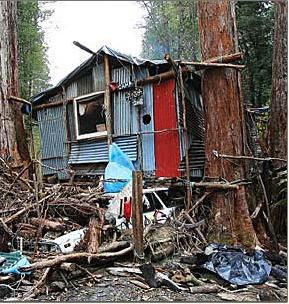 It was not supposed to be flash
because a permanent structure would have invited legal demolition
It was not supposed to be flash
because a permanent structure would have invited legal demolition
.
February 2007 – Government Bully Bust #1
.
On 21st February 2007, The blockade was raided by over 40 police and Forestry Tasmania workers and 16 arrests were made over the following 3 days. However, a complex system of structures was built and Camp Florentine continued. In October 2008, logging commenced in coupe FO042E in the Upper Florentine valley and was met with two actions, one resulting with physical assault on protesters by contractors. Footage taken at the action went national in the media and highlighted the ongoing violence that protesters face in the forest.
Not long after his media attention two cars and the info hut were torched one night resulting in even more media coverage.
.
January 2009 – Government Bully Bust #2
.
In mid January 2009, the blockade was busted for the second time by 65 police and Forestry Tasmania workers. Again there were 16 arrests in the first 3 days and after the tunnel and dragons and winter shack were removed the machines came in and carved a massive scar a further 3km into the pristine valley, to be a logging road. After 11 days of continuous actions to try and slow down further road construction and logging the machines weretaken away and we started rebuilding on the road again.
‘…In the Upper Florentine Valley today, the Battle of Coupe FO044A entered a second day (13th January) with six activists up trees — and one down a hole — holding out against arrest amid the ruins of their two-year-old protest camp.
Forestry Tasmania has requested police remove the camp which is hindering plans to build road and to harvest trees from a 25ha coupe in the area. (Ed: didims!)
Derwent District Forest Manager Steve Whitely (Ed: a hardcore logger) said Forestry Tasmania respected people’s right to protest peacefully and legally, but Camp Flozza was neither.
“The camp has been there for some time but it has degenerated into a slum and as shown late last year it has the potential to become a real flashpoint of conflict over this summer,” he said. “We ended up with a couple of conflict situations last year that were really quite serious and we really took stock that this camp wasn’t just a slum in the forest as some people saw it but in fact a place where extremists launched raids on various other places and actually generated conflict.
That’s when it was realised it wasn’t just an eyesore but something more serious than that.”
He said the logging in the valley will be small in scale and sensitive to the area’s conservation values but admitted up to 90 per cent of the old growth forest harvested will end up as woodchips.
“The Upper Florentine is an important place for both conservation and wood production,” he said. “In fact up to 90 per cent of the Upper Florentine is protected or not available for wood production.
“We recognise the values of the area and with that in mind we’re operating at a small scale, there’s no clearfelling in the area at all, there is to be no plantations established all of the forest that is harvested will be resown with natural seed and there will be no chemicals used in the area or fertilisers.
“It’s high-quality timber, it’s been grown over a number of years, it’s some of the higher value timbers that will be supplied to the local mills.
“On average I think we find that between 10 and 20 per cent, depending on the quality of the forest, is taken off as sawing-grade products and there’s some other milling grade products which can be recovered and then the rest of it is sold to make paper.”
[Source: ‘Protest camp ‘a slum’, by David Killick, The Mercury newspaper (Hobart), 20090113, ^http://www.themercury.com.au/article/2009/01/13/49521_tasmania-news.html].
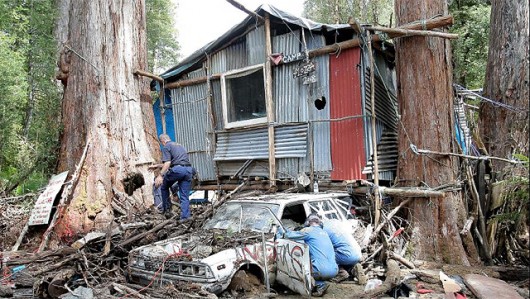 Police move in on protesters at Camp Flozza in the Florentine Valley
[Photo by Niki Davis-Jones]
Police move in on protesters at Camp Flozza in the Florentine Valley
[Photo by Niki Davis-Jones]
.
“..Push came to shove in the Upper Florentine Valley yesterday. Scuffles broke out as about 200 protesters confronted a line of police blocking access to a contested logging road.
Police arrested 15 people during yesterday’s Community Walk-In For the Florentine march.
In a short but heated exchange, several protesters broke through the the frontline of about 30 officers but were quickly tackled and arrested. No injuries were reported.
Over the course of the day about two dozen forest activists managed to infiltrate the logging site. One halted forestry operations for several hours after locking himself to logging equipment before police cut him free.
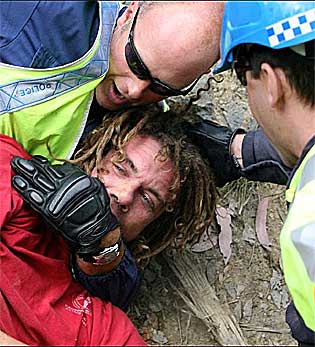 Tasmania Police act as cheap bouncers for the loggers
Tasmania Police act as cheap bouncers for the loggers
.
Some of the others were escorted from the area by officers, while others were arrested for refusing to leave an exclusion zone around forestry operations near Timbs Track, off Gordon River Rd, west of Maydena.
Those arrested yesterday were charged with a range of offences including assaulting police, trespass, obstructing police, disobeying the lawful direction of a police officer and breaching bail conditions. They were taken by bus to the Hobart police station. Thirteen were granted bail and two others appeared in court last night. Simon Christopher Browning, of Huonville, and Lauren Athalie Campbell, of Adelaide, were remanded in custody for breach of bail and will appear in the Hobart Magistrates Court this morning.
After the initial confrontation about 11am, the remainder of yesterday’s protest was peaceful. There have been 20 arrests during the police operation in the area. Forestry Tasmania ‘asked‘ police to clear the area surrounding the so-called Camp Flozza of protesters on Monday.
 Camp Flozza – Government Bust in January 2009
[Source: The Mercury – Photo by Raoul Kochanowski]
Camp Flozza – Government Bust in January 2009
[Source: The Mercury – Photo by Raoul Kochanowski]
.
Most of the old-growth forest to be cut in the area will become woodchips. The two-year-old protest camp was destroyed on Tuesday although four protesters continued a vigil on two treetop platforms. They could be heard shouting their defiance throughout yesterday’s protest. Police inspector Glen Woolley (Ed: hardcore logger sympathiser) said the outbreak of violence was regrettable.
“It’s very disappointing. Up until this stage the protest has always been peaceful,” he said. “The police presence is here to ensure that business operations were able to continue, however the activists have decided they would use some force to force their way through the blockade. “When they did force their way through the blockade, we were prepared for them and they were arrested very quickly.”
Police called for re-inforcements after the initial scuffles, boosting their numbers to nearly 60. Protester Bronwyn Smith said she attended yesterday’s protest because she believed the old forests were part of the state’s heritage. She said: “It’s much older than Port Arthur, they’ve never seen a chainsaw, there’s been very little disturbance.
“Can you imagine what it would be like today if they were at Port Arthur pulling down the ruins?
“We live in a dying world. We live in a world that’s becoming less and less tenable and less and less viable. And that’s in part because of the clearing of forest like what’s happening here.”
Fellow campaigner Patsy Harmsen said the logging had to be stopped. “It shouldn’t be happening, it mustn’t go on. It’s just the most shocking worldwide shame,” she said.
Ula Majewski, of the group Still Wild Still Threatened, said the largeHeadline: face-off turns nasty turnout for a weekday protest organised at short notice showed the strong support of the old-growth anti-logging cause.
“Once again, we are seeing a massive swell of community support for Tasmania’s carbon-dense old-growth forests and outrage at the destructive roading, logging, woodchipping and burning of these precious ecosystems by local climate criminals Forestry Tasmania and Gunns Limited,” she said.
“Our community will continue to stand up and speak out against these environmentally criminal acts. In this era of dangerous climate change, the destruction of Tasmania’s ancient forests is a global issue.”
She said there would be further protests.
Wilderness Society spokesman Vica Bayley said the forestry operations in the area showed Premier David Bartlett was no different to his predecessor on forestry issues.
“The Bartlett Tasmania is in the grip of the same greed-driven woodchip frenzy that ex-premier [Paul] Lennon promoted with such blinkered commitment,” he said.
“It makes a mockery of the clever and kind Bartlett rhetoric when carbon-rich old-growth forests in an intact valley of World Heritage value are being opened up with a brand new logging road for clearfelling.”
Late yesterday, Derwent district forest manager Steve Whiteley said contractors had resumed work.
“Our staff and contractors are cleaning up the site of Camp Florentine and undertaking road repair and construction,” he said. “We have had plans in place for several years to harvest a 50ha coupe and to build four kilometres of road. “This year, we plan to harvest 25ha of this area, using a variable retention technique we have developed as an alternative to clearfelling. “The timber is being harvested to meet market conditions. All harvested areas will be regrown as native forest.”
Mr Whiteley said the wood was essential for Forestry Tasmania to meet its legislated requirement to supply 300,000 cubic metres of sawlogs and veneer logs annually. However, most of the old-growth forest to be cut is destined to be come woodchips. Police are expected to scale down their presence today.
[Source: ‘Arrests at Camp Flozza’, by David Killick, The Mercury newspaper (Hobart), 20090114, ^http://www.themercury.com.au/article/2009/01/14/49611_tasmania-news.html].
May 2009 – Government Bully Bust #3
.
‘In early May 2009, Forestry Tasmania came back into the area to log the coupe. It was Mother’s Day.
A huge police operation that lasted a whole month accompanied Forestry Tasmania’s bulldozers chain saws and log trucks. Almost every log truck that left the area got a police escort of a dozen cops jogging alongside!
The Cops had a mobile cop shop bus parked in the clearfell so they could process arrestees on site. The operation sucked most of the states police resources for the month of May as they maintained a constant 24 hour presence in the logging area for the entire month. Of course when the police association complained about the drain on resources, the government blamed us.’
[Source: Still Wild Still Threatened].
Logger Ecoterrorism Culture
.
Miranda Gibson:
‘This is yet another act of violence against the non-violent protest movement. This was not the first time that such acts of intimidation had been committed towards the protesters and community involved in the camp.
‘In 2008 when there was a fire-bomb attack on the camp in the middle of the night, many people were there and were awoken in terror. Two people at the camp had their cars set on fire by the attackers, as well as the camp’s information center being torched.
That incident occurred within days of a violent assault on myself and another protester at a peaceful action in another part of the Upper Florentine Valley. Logging contractors used a sledgehammer to attack a car that we were in. Smashing glass in on us and screaming abuse. When we eventually managed to get out of the car, fearing for our lives, my fellow protester was dragged to the ground and kicked in the head.’
.
How the incident was reported back in 2008..
“…Police have been called to investigate a film showing protester’s car being smashed by logging contractors. Protesters have posted footage of the attack by logging contractors on the Internet. They say one contractor kicked a man’s head when he was escaping from the car during the Upper Florentine Valley confrontation.
A representative of forest contractors said they had been pushed to the limit and he predicted further violence in the forests. He called on Gunns and Forestry Tasmania to compensate workers. The video shows several men, one wielding a sledgehammer, and one screaming expletives and abuse and smashing windows of the car.
The man and woman protesters were using a “dragon” technique, in which they put their arms into a pipe running through the floor of the car and into a concrete block in the ground below.
“The man was trying to get out of the car and he was pulled out and kicked in the head,” said Ula Majewski, spokeswoman for protest group Still Wild Still Threatened. She said a Forestry Tasmania staff member warned protesters to get out of the car before the attack but then stood by.
“Members of the Tasmanian community engaged in legitimate peaceful protest should not be subjected to this kind of violence, nor should it be condoned by a Forestry Tasmania employee,” Ms Majewski said. She said the FT employee could be seen in the video, which is on the public video website Myspace.
Forestry Tasmania last night said it had asked police to investigate the video footage.
Acting general manager operations Steve Whiteley said the staffer denied witnessing the violence. “Forestry Tasmania staff at today’s protest had provided a categorical assurance that he didn’t witness any confrontation while he was at the scene and did not receive any complaint,” Mr Whiteley said.
Australian Forest Contractors Association chairman Colin McCulloch said the contractor involved had had his work interrupted several times and had lost about $30,000.
“These loggers should be compensated by the industry or Government,” he said, adding that Gunns and Forestry Tasmania should pay in this case.’
[Source: ‘Forest violence filmed’, by Michelle Paine, 20081022, The Mercury newspaper (Hobart), ^http://www.themercury.com.au/article/2008/10/22/34071_tasmania-news.html].
2008 Fire Bombing of Camp Flozza:
.
.
Camp Floz, more than a protest camp
.
“Florentine camp has been in place for the past five years as a frontline defence to protect the Upper Florentine. There have been violent attacks on the camp in the past. This valley is one of Tasmania’s most iconic high conservation value forests yet the current negotiations have failed to provide certainty for the future of this area. The camp is operating as an information centre, providing opportunities for tourists to take walks through the forest and find out more about the area”, said Ms Gibson.
“Sometimes I really miss the Floz and one thing I am looking forward to when I get down from this tree is going back to walk in the forest around the camp and visit all my favorite little spots. And I care deeply about all the people who are spending their time maintaining the camp. And it is hard for all of them to have to be out there this weekend, shifting through the ahes and rebuilding the camp again.”
“There is an odd lack of curiosity in the camp. People float in and out, asking a few questions of one another, as if the past is erased and this, what they are now, is all that matters.”
[Source: ‘Into the Woods: The Battle for Tasmania’s Forests‘, by Anna Krien, 2010, p.38, published by Black Inc. Publishing, ^http://www.blackincbooks.com/books/woods].
http://www.youtube.com/watch?v=8SsQrXhNwdI
.
Camp Florentine arson attack Sunday 9th September 2012
.
‘Anti-forestry protesters have reported an apparent arson attack on a well-known protest camp in the Upper Florentine Valley. Activists say a large area of Camp Florentine has been destroyed by fire. They believe it happened earlier this week.
Jenny Weber from the Huon Valley Environment Centre says there were no protesters at the site at the time of the fire because they had been helping at a tree sit.
“It’s very serious because it’s an arson attack, it’s a pattern that we’ve seen before where arson has been used against the protesters camp at the Florentine Valley,” she said. “Even though people weren’t there at the time, it’s also a threat to what we believe in and the very real fact that we’re standing up for Tasmania’s forest.”
[Source: ‘Forest activists’ camp torched, ABC, 20120913, ^http://www.abc.net.au/news/2012-09-13/forest-activists27-camp-torched/4259124].
Miranda Gibson:
“Environmentalists have been targeted by the industry in calls for durability despite the fact that our actions are always peaceful. The question is, will these same critics be condemning this violent attack on the conservation movement? There has been a great show of support from the community, in response to this act of violence. We have received many calls from people in the Derwent valley and offers of support to help with rebuilding the camp, which has began today.”
Environment Tasmania today condemned the reported arson of Camp Florentine and condemned all violence towards person or property as totally unacceptable, and welcomed the police investigation into the incident.
“It is very fortunate no-one was present or hurt during this incident and we welcome the police investigation,” said Dr Phill Pullinger, Director of Environment Tasmania. But it was also wonderful to receive so much support from the community and offers of help to rebuild. I guess it is a perfect time for a spring clean!
And with so much help, I’m sure they will be able to build an even better camp. And so Camp Floz will, as it always has, rise up from the ashes.
.
Comments on Tasmanian Times:
.
Ron, 20120913:
“Nothing in the mainstream newspapers? When forestry equipment gets damaged you dont hear the end of it.”
.
Garry Stannus, 20120913:
” The last time it was wrecked, was by the police. And the time before that …? ..the brotherhood roguery of Forestry Tasmania?
.
William Boeder, 20120914:
“I can envision in my mind the snortings and sniggerings going on between the many upper level individuals that orchestrate the denudation of our Old Growth Forests, (along with the incumbent wildlife species and ecosystems,) this must give each individual attendant to and associated with this plundering consortium of Neanderthals the most enormous mirth.
Across the top end waters of Australia’s North a like-minded family of Malaysians have almost completely destroyed their own natural forests and the many homes of their indigenous people, all this for the life-killing tainted dollars that they now have squirreled away for themselves, yet now they are greedily and cunningly sourcing their cheaply negotiated timber product from our Tasmanian people’s forests, thanks to our feckless State government of Lib/Labbers…”
.
John Hayward, 20120915:
“I can’t see any great moral difference between obliterating the camp and obliterating the surrounding forest. The same contempt for everyone and everything else is apparent in both.”
.
[Source: ‘Arson attack against Camp Florentine’, by Miranda Gibson (Still Wild Still Threatened), 20120914, Tasmanian Times, ^http://tasmaniantimes.com/index.php?/weblog/article/arson-attack-against-camp-florentine/].
Was it misguided logger payback?
.
Less than a week before the arson attack on Camp Flozza, Tasmanian news media reported that vandals had caused about $750,000 damage to logging machinery in a Forestry Tasmania logging coupe.
 Who attacked Les Walkden’s machinery at Butlers Gorge?
Who attacked Les Walkden’s machinery at Butlers Gorge?
.
The media report ran thus:
…’Police were called to the logging coupe near Butlers Gorge in the Central Highlands early yesterday morning and found two damaged excavators and a skidder. One excavator had been used to ram the other two pieces of machinery. Private contractor Les Walkden owns the equipment.
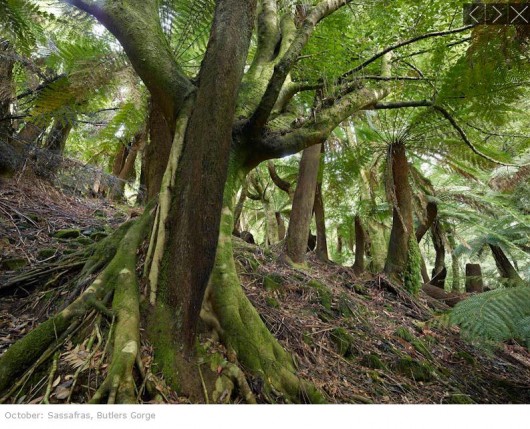 [Source: ^http://www.robblakers.com/products/large-calendar]
[Source: ^http://www.robblakers.com/products/large-calendar]
.
“It’s extremely upsetting especially when your workers have got to go to work and find that,” he said. “I just hope that we can catch these people and, if we do, I can assure you…they’ll be (pursued to) the full extent of the law, we just can’t have this sort of thing going on. “We’re supposed to have peace with this forest agreement that’s being mooted at the moment and its just disgusting.”
Mr Walkden says he will have to stand workers down until new equipment is sourced and the site is forensically examined.
Ed Vincent, from the Forest Contractors Association, says it is another blow to a struggling industry. “Vandalism by whomever is to be abhorred.”
The State Opposition has condemned the damage, saying its proof the forest conflict is not over.
[Ed: This media statement by the Tasmanian Liberals is unsubstantiated, presumptive and spiteful and has likely become the incitement causing the arson at Camp Flozza and the Tasmanian Police ought to investigate who made this statement as part of their arson investigation.]
[Source: ‘Vandals hit logging machinery’, 20120904, ABC, ^http://www.abc.net.au/news/2012-09-03/vandals-hit-logging-machinery/4239326].
Just two days hence, and just three days before the Camp Flozza arson attack, came a second related report of property damage to the same industrial logger.
The Tasmanian news media report ran thus:
‘Police believe an arson attack at a forestry company’s New Norfolk offices on Tuesday night is linked to the vandalism of forestry machinery over the previous weekend.
“The office and dining area was entered and multiple fires were started,” Detective Constable Craig Fry said. “It appears some sort of flammable liquid was used in the incident,” he said.
Detectives believe the fire at Les Walkden Enterprises at 69 Hamilton Rd was started at 11.40pm. It caused an estimated $50,000 damage.
“The fire is being investigated in conjunction with a recent incident involving damage to two excavators and a logging skidder, also owned by Les Walkden Enterprises,” Constable Fry confirmed. The vandalism attack caused $750,000 damage and was carried out at a logging coupe 12km south of Butlers Gorge in the Central Highlands on Saturday night.
“The attacks on the business do not appear to be linked to any kind of protest activity,” Constable Fry said.
Anyone with any information is asked to contact Crime Stoppers on 1800 333 000.
[Source: ‘Forestry firm hit again’, 20120906, by Zara Dawtrey, The Mercury, ^http://www.themercury.com.au/article/2012/09/06/359231_tasmania-news.html].
Yet the Tasmanian forest environmentalist campaigns have been consistently non-violent.
The fundamental core of the environmentalists defending the magnificent Florentine is non-violent protest.
All participating groups have a policy as such and the protest record is consistently non-violent. Importantly , the two night-time attacks on Les Walkden Enterprises have been confirmed by the investigating police detectives as not connected with environmental protest. It could more likely be a disgruntled past employee seeking revenge or some other criminal attack targetting specifically Les Walkden Enterprises, and happy to have blame attributed to environmentalists.
Indeed, the modus operandi of the night time attacks on Les Walkden have similarity with the attack on Camp Floz.
Yet as night follows day, within a few days Camp Flozza is torched, following the Tasmania Opposition publicly implying that this damage was associated with the “forest conflict”. How irrespponsible?
So what involvement did Tasmanian loggers play in this misguided arson attack on Camp Flozza just two weekends ago? Police ought to be taling to the local Forestry Tasmania crews under Scott Marriott, asking questions whther anyone saw anything; about who was where when around the local Maydena logger haunts like the National Park Hotel, the Maydena RSL and the New Norfolk Hotel. What vehicles were seen travveling along the Gordon River Road west of Maydena on the night of Sunday 9th September 2012?
Word of mouth says that in the days between the two attacks on Les Walkden Enterprises logging operations and the arson attack on Camp Flozza, loggers on Facebook were fuming and texting prolifically threatening retaliation against ‘Green scum’ and ‘Green terrorists’. Police investigation of social media could well identify the culprits of all three attacks.
One Tasmanian logger page on Facebook includes correspondence on a known Tasmanian logger page is telling of the angst.
.
.
“…the interim protection order on forests locked up for the IGA expired at midnight this Saturday just gone. Some of that forest was in the Buttlers Gorge area. Walkdens machinery was burnt out in the Buttlers Gorge area this weekend just gone, then his offices at New Norfolk….. co-incidence or not?”
.
“How would they like it if someone did this to their property??? They’d squeal like crazy. Makes me so angry when they do this.”
.
“Find them and cut off their centrelink payments plus jail time of 4 year. the governemnt BAN and shut down everything else so what not shut down the greens and BAN them.”
.
“Hope they catch the dickheads that did this soon, someone must have seen strangers in the area they didnt walk there .”
.
Jarrod Halsall should be nmade to pay for the damage done intil its completely paid should come out of there own back pocket ill go set there green alight and there propbety gutless doggs.”
.
“I suspect that there are a couple of lackwit bogans somewhere sniggering about how they not only got away with it, but the “greenies” are being blamed. No doubt a double bonus to persons of that ilk.”
.
“K***’are you really so gullible and naive that you think this is not the handywork of Green terrorists? Have a talk to Jenny – I believe she has a great little hand book on this kind of thing – Im sure you are aware of it?”
.
.
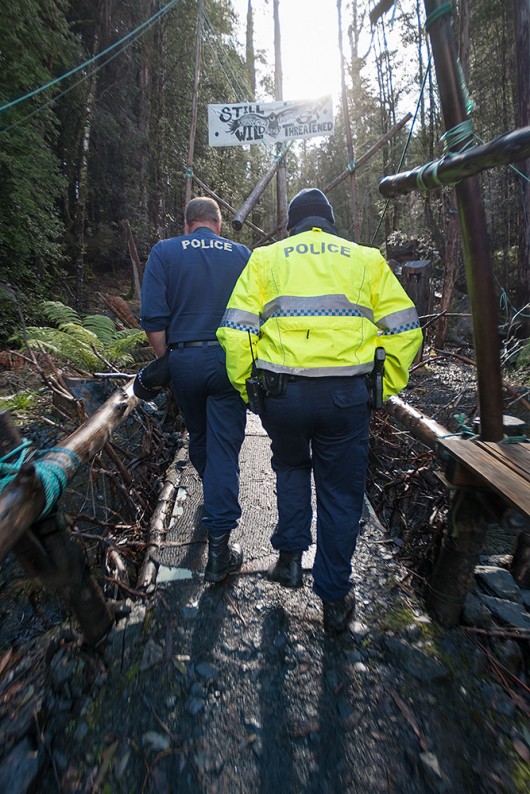 Police inspect the arson attack, Thursday 20120913
Police inspect the arson attack, Thursday 20120913
.
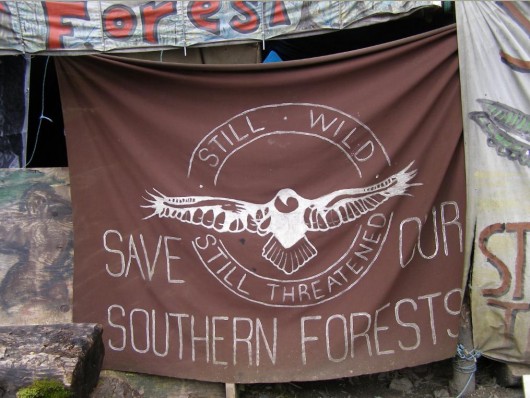 Still Wild Still Threatened – visit their ^website
Still Wild Still Threatened – visit their ^website
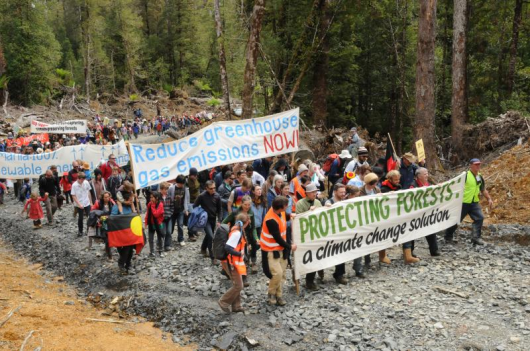

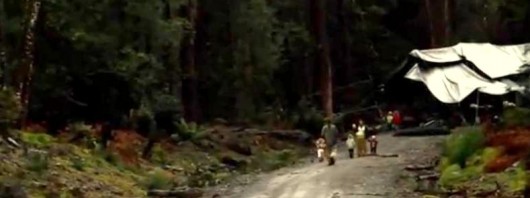
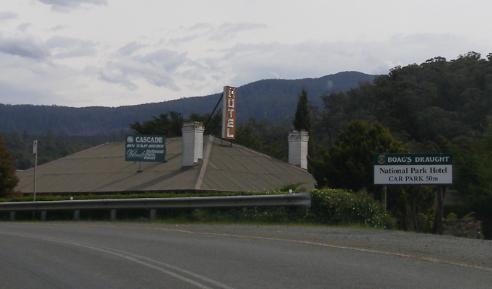
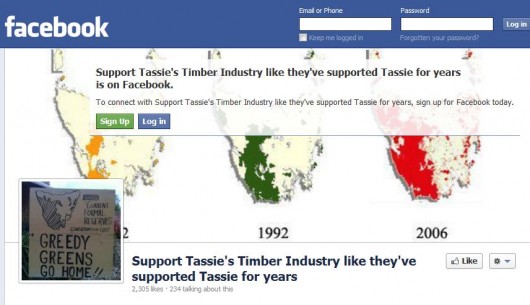
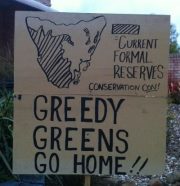
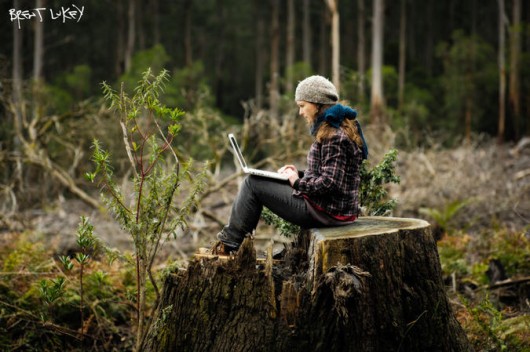
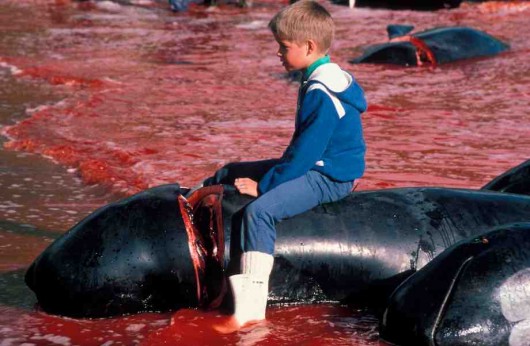
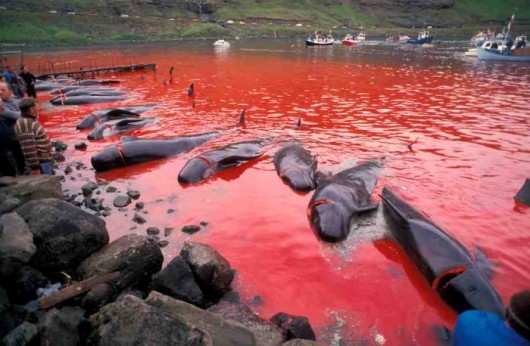
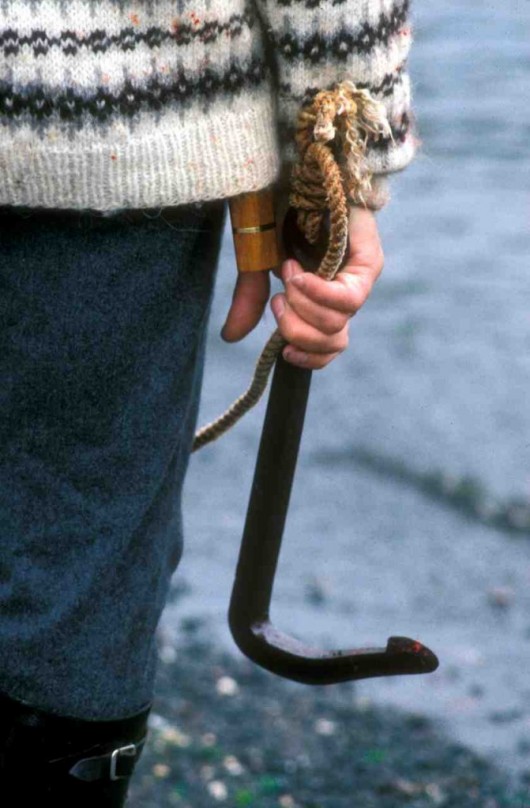
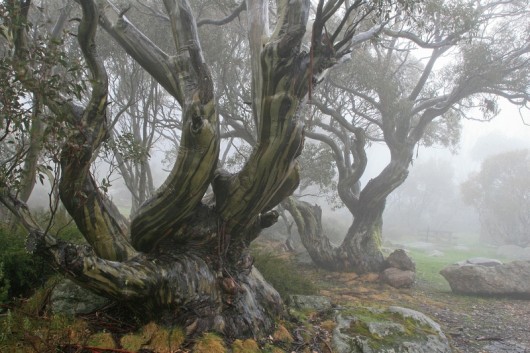
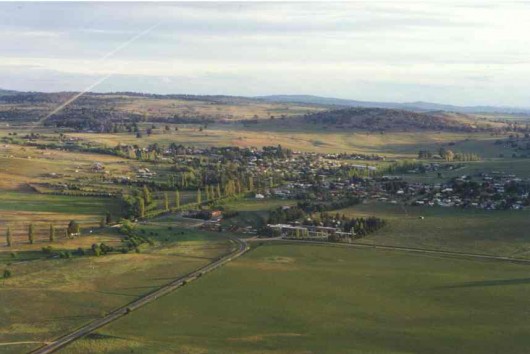

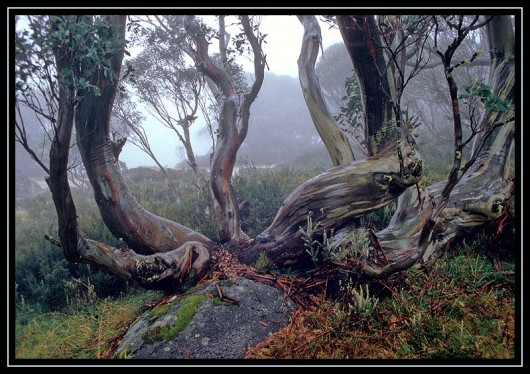 Snow Gums do not enjoy being burned to death
Snow Gums do not enjoy being burned to death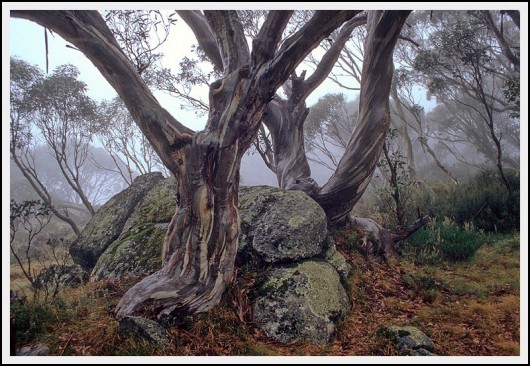
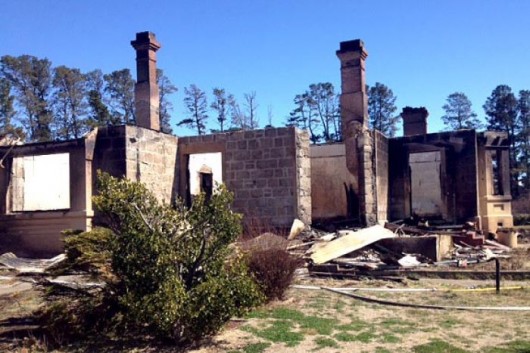

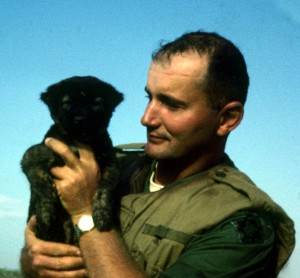 Captain Michael D. Miller in 1968
[New life amongst so much death]
Captain Michael D. Miller in 1968
[New life amongst so much death]
